The Val d’Orcia is a little oasis of peace, bucolic lifestyle and ravishing landscape, where the time seems to have stopped. You will find no industrial estates nor modern buildings. Just picturesque villages and farms with cypresses avenues. This typical Tuscan postcard landscape will steal your heart.
I just came back from a holiday in Tuscany where I spent 3 days exploring the Val d’Orcia but the more you see of this enchanting area the more you want to go back. If you want to know what to see in Val D’Orcia, check my recommendations below.
WHAT TO SEE IN VAL D’ORCIA
PIENZA
Pienza, is absolutely a must-see sight. Pienza is a UNESCO World Heritage site and it is also known as the “ideal city”. What does this mean you might wonder? Well, the concept of the ideal city originated during the Renaissance and is based on Humanism’s values. According to these values, humans have great potential and through the study of the ancient Greek and Roman texts, they can achieve great results. Humans are the centre of the universe. Because of this, a city should be built to facilitate people’s actions and life. Pienza is that city.
WHAT TO SEE

I would suggest that you start your walk around Pienza from Porta del Murello. From here walk along Corso Il Rossellino until you arrive to Piazza Pio II. This is the main square where you will find PALAZZO PICCOLOMINI and Santa Maria Assunta’s DUOMO, PALAZZO BORGIA and PALAZZO COMUNALE. The first three buildings are open for visits, but you can still enjoy Pienza simply by wandering around the streets and its picturesque corners. Just outside town, there are the Pieve di Corsignano and the Romitorio. Check my detailed Pienza travel guide for more information about Pienza and what to do.
SECRET LOCATION IN PIENZA
Not everyone knows that just outside Pienza, there is one of the locations of the Gladiator film, probably the most iconic. Do you recognise it?

CAPPELLA DI VITALETA
This is a dreamlike, otherworldly location, with a peaceful and mystical atmosphere. The little church, made of stones, stands at the top of a hill, surrounded by cypress trees. It seems perfectly merged with the nature around it. Sloping field of wheat and grass, gently moving in the wind.
It is one of those places that must be seen at different times of the day to appreciate the view with different lights and colours. The church is located between Pienza and San Quirico d’Orcia: you will see the sign.

There is an unpaved road up to the car park, which is not big, but you can park on the side of the road. At least it was like that when I went but there were some works so it might be different next time you go. There is also a small bar with some tables in the old building beside the church (which in my opinion, spoils a bit the panorama!)
SAN QUIRICO D’ORCIA
About 15/20 minutes driving from Pienza and 10 minutes from Bagno Vignoni, there is San Quirico d’Orcia. Originally, it was an Etruscan town, then, it grew in importance thanks to its position along the Via Francigena. The ancient pilgrimage road that drove pilgrims from the Land of the Franks to Rome.

San Quirico d’Orcia represents one of the best examples of medieval town. Make sure you see the Collegiata church with three beautiful doorways in Romanesque style, Palazzo Chigi, which is next to the Collegiata and the Horti Leonini gardens.
BAGNO VIGNONI
Bagno Vignoni is a little, charming spa village. The square of water in the centre of the village is just the icing on the cake, making it the perfect spot for a photo. It used to be a popular location in the past. In fact, people like Lorenzo De Medici and Pope Pio II Piccolomini, used to stay here quite often. However, their popularity is even older, as the thermal baths were well known by the Etruscan and the Romans as well.

Enjoy a fresh smoothie or an “affogato al caffe” at the “Terrazza enoteca & bar” and then check the old mills’ ruins. These are most particular because the thermal water was taken by a system of canalisation directly from the spring pool. One of these canals has still running water that flows and jumps over the cliff. From here you will enjoy a stunning view over the valley and the natural thermal pools at the bottom of the valley.
Little secret tip:
bring along your swimsuit! You can dip yourself into the natural thermal springs for free!
MONTALCINO
Montalcino is famous all over the world for its prestigious wine “Brunello Di Montalcino”. This village is approximately 40 km from Siena and 20 km from Pienza. We got there from the route SP14 and if you turn left at the roundabout in Via Aldo Moro, you will find a car park (some spaces are free of charge). From there, there are some stairs to climb to the Rocca, the fortress built in 1361. Here, every year in July, is held the Jazz & Wine Festival. More spaces are in front of the fortress if you are like enough to find one.

Montalcino is a hilltop town almost unchanged since the XVI century. From the Rocca take via Ricasoli and then Via Spagni to get to the Cattedrale Del Santissimo Salvatore.
From here Piazza Del Popolo, the main square, is just 5 minutes away. It will be a nice walk through the narrow streets of Montalcino. The main feature of this is square is Palazzo Dei Priori.
Also, ensure you pay a visit to Sant’Antimo Abbey which is only 12 minutes away from Montalcino. Sant’Antimo is a gorgeous example of a Romanesque church, drenched in the Tuscan countryside. You will savour a mesmerising atmosphere of peace and harmony in this corner of Tuscany. You could still hear the Gregorian chants and practice them as well by taking part in a workshop. For more information visit their website https://www.antimo.it/.
RADICOFANI
Not as much as popular as Pienza or Montalcino, there is Radicofani. It might be lesser-known but this doesn’t mean that is not worth a visit. Unfortunately, I haven’t had time to go myself. This location is going to be on my list for my next trip to Tuscany! However, I have seen it from the road, on my way to Pitigliano and it’s stunning.

The top hill fortress with the tower dominates the landscape and the views from there must be stunning. I also picked an interesting and curious piece of information. Along the road SP478 towards Radicofani, there is the Casale Della Posta, where pilgrims and travellers used to rest. It appears it hosted some famous people such as Charles Dickens, Casanova, Stendhal, and Goethe.




